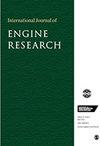A consistent model of the initiation, early expansion, and possible extinction of a spark-ignited flame kernel
IF 2.1
4区 工程技术
Q2 ENGINEERING, MECHANICAL
引用次数: 0
Abstract
Modelling the establishment and growth of spark-ignited (SI) flame kernels has always been a topic of great interest, especially due to their key role in affecting the performance of SI engines. A major issue is that the unsteady conditions and the small kernel size hinder the application of the typical (both linear and non-linear) flame stretch correlations, valid only long after the ignition stage. Overcoming such limitations, this work presents a novel, mathematically consistent, and compact model that enables prediction of flame kernel initiation and early expansion, including its possible extinction. Firstly, spark-driven initiation models from literature are discussed, and an effective flame kernel initiation method is proposed. Then, the expansion model is defined complementing the mass, energy, and species conservation equations for the spherical kernel with the reactant and temperature profiles outside of it using the theory of transient thermodiffusive flames. After accounting for the convective flow caused by the combustion-induced density reduction and the variable thermodynamic properties of the reacting fuel/air mixture, the result is a two-equation model that predicts the kernel expansion even up to its possible extinction due to flame stretch. After calibration of the expansion model, successful validation is achieved against literature data on lean propane/air flames, and the influence of the model parameters is examined in detail. The proposed expansion model is formulated also aiming for inclusion into the simulation of combustion in SI engines, enabling more accurate predictions at part loads, as well as more effective estimation of the cycle-to-cycle variation thanks to the good model sensitivity to the parameters most affecting the ignition.火花引燃火焰内核的起始、早期膨胀和可能熄灭的一致模型
火花点燃(SI)火焰内核的建立和增长建模一直是人们非常感兴趣的话题,特别是因为它们在影响 SI 发动机性能方面起着关键作用。一个主要问题是,非稳态条件和较小的内核尺寸阻碍了典型(线性和非线性)火焰拉伸相关性的应用,因为这些相关性仅在点火阶段后很长时间内有效。为了克服这些局限性,本研究提出了一种新颖、数学上一致且结构紧凑的模型,可以预测火焰内核的起始和早期扩展,包括可能的熄灭。首先,讨论了文献中的火花驱动起燃模型,并提出了一种有效的火焰核起燃方法。然后,利用瞬态热扩散火焰理论,对球形焰心的质量、能量和物种守恒方程以及焰心外的反应物和温度曲线进行了补充,从而定义了膨胀模型。在考虑了燃烧引起的密度降低所导致的对流以及反应燃料/空气混合物的可变热力学特性后,得出了一个双方程模型,该模型可以预测内核的膨胀,甚至可以预测由于火焰伸展而可能导致的内核熄灭。在对膨胀模型进行校准后,根据有关贫丙烷/空气火焰的文献数据成功地进行了验证,并详细研究了模型参数的影响。由于模型对影响点火的主要参数具有良好的敏感性,因此所提出的膨胀模型还可用于模拟 SI 发动机的燃烧,从而在部分负荷下进行更准确的预测,并更有效地估算周期间的变化。
本文章由计算机程序翻译,如有差异,请以英文原文为准。
求助全文
约1分钟内获得全文
求助全文
来源期刊

International Journal of Engine Research
工程技术-工程:机械
CiteScore
6.50
自引率
16.00%
发文量
130
审稿时长
>12 weeks
期刊介绍:
The International Journal of Engine Research publishes high quality papers on experimental and analytical studies of engine technology.
 求助内容:
求助内容: 应助结果提醒方式:
应助结果提醒方式:


